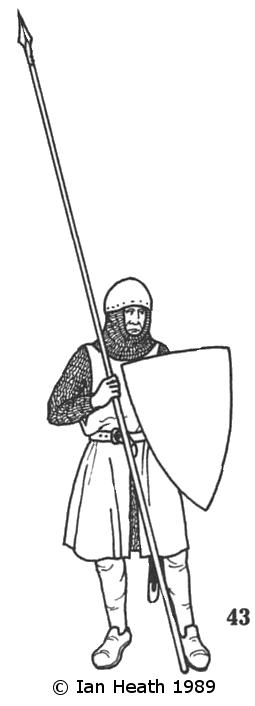BRABANCON OR FLEMISH SPEARMAN, 12th-13th CENTURIES
 An extract from Armies of Feudal Europe 1066-1300
An extract from Armies of Feudal Europe 1066-1300by Ian Heath
 An extract from Armies of Feudal Europe 1066-1300
An extract from Armies of Feudal Europe 1066-130043. BRABANCON OR FLEMISH SPEARMAN, 12th-13th CENTURIES
This figure is based on carvings on a chest depicting scenes of the Courtrai campaign of 1302 and the Leugemeete fresco in Ghent of similar date, destroyed in the mid-19th century (see figure 66 in Armies of the MiddleAges, volume 1). Although he therefore dates to the close of this period he is nevertheless typical of the high-quality, well armed and armoured Brabanšon and Flemish mercenaries who featured in so many Western European armies of the 12th and 13th centuries that, as we have already seen, the word Brabanšon even became a synonym for mercenary infantryman. Though rapacious, these tended to remain loyal as long as they were paid punctually. This man wears a helmet and long-sleeved hauberk. The spear remained some 10-12 feet in length throughout this era.
The Low Countries were making extensive use of such infantry, armed with long spears called geldons, as early as the 11th century, but as mercenaries their heyday was the period from c. 1100 to 1214, their last notable appearance in a mercenary role being at Bouvines. Fighting on behalf of their own country such Flemish spearmen were later to achieve a classic victory over the French at Courtrai.
[Based on the Courtrai chest and Leugemeete fresco]